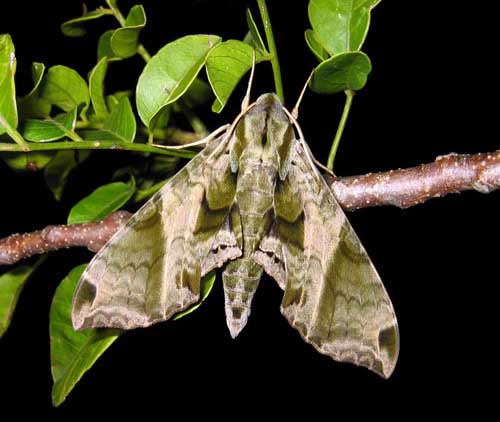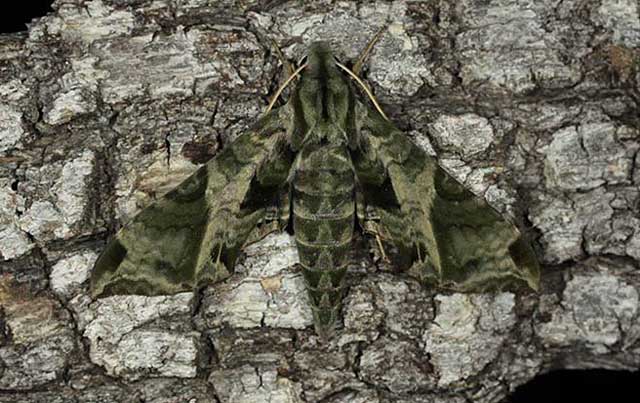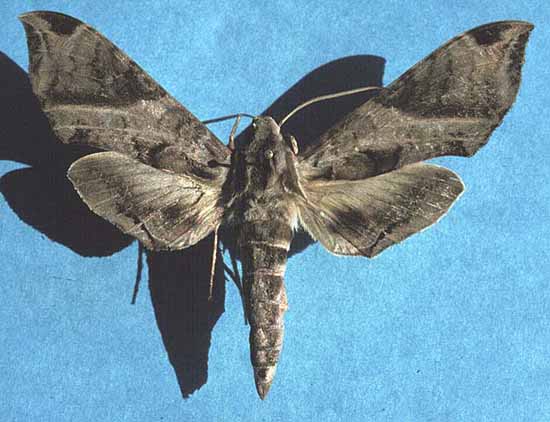Eumorpha elisa
Eumorpha elisa
you-MOR-fuhmm
eh-LIS-uh
(Smyth, 1901)
Philampelus

Eumorpha elisa, Huehuetenago, Guatemala, courtesy of
Jose Monzon Sierra.
This site has been created by
Bill Oehlke at oehlkew@islandtelecom.com
Comments, suggestions and/or additional information are welcomed by Bill.
| TAXONOMY:
Superfamily: Sphingoidea, Dyar, 1902
Family: Sphingidae, Latreille, 1802
Subfamily: Macroglossinae, Harris, 1839
Tribe: Philampelini, Burmeister
Genus: Eumorpha, Hubner, [1807]
Species: elisa, (Smyth, 1901) |
MIDI MUSIC
"What.A.Wonderful.World"
copyright C. Odenkirk
MIDI CITY
ON.OFF
<bgsound src="world.mid" LOOP=FOREVER>
|
DISTRIBUTION:
Eumorpha elisa flies in
Mexico: Sonora (JH) and
Guatemala: Huehuetenango.
Bruce Walsh reports a sighting on August 26, 2010, at MS lights, along the Foothills Road, just
north of Portal (on the plains just east of the Chirichahua Mts.), Cochise County, Arizona. Id has been confirmed by
Ian Kitching.
FLIGHT TIMES AND PREFERRED FOOD PLANTS:
Eumorpha elisa adults are on the wing in June and August and probably in other months.

Eumorpha elisa Sonora, Mexico,
July 2014, courtesy of Jean Haxaire.
Eumorpha elisa larvae likely feed upon grape species.

Eumorpha elisa courtesy of Bruce Walsh.
The genus name "Eumorpha" means well-formed.
"Elisa" is possibly for a friend.
The pronunciation of scientific names is
troublesome for many. The "suggestion" at the top of the page is
merely a suggestion. It is based on commonly
accepted English pronunciation of Greek names and/or some
fairly well accepted "rules" for latinized scientific names.
The suggested pronunciations, on this page and on other pages,
are primarily put forward to assist those who hear with internal
ears as they read.
There are many collectors from different countries whose
intonations and accents would be different.
ECLOSION, SCENTING AND MATING:
Pupae wiggle to surface just prior to eclosion. Females call at night, and males fly into the wind to pick up and track the pheromone plume.
EGGS, LARVAE AND PUPAE:
Green eggs are deposited singly on host foliage.
Mature larvae leave host plants and pupate in underground burrows.
Larval Food Plants
Listed below are primary food plant(s) and alternate food plants. It is hoped that this
alphabetical listing followed by the common name of the foodplant will
prove useful. The list is not exhaustive. Experimenting with closely
related foodplants is worthwhile.
Use your browser "Back" button to return to the previous page.
Return to U. S. A. Table
Return to Philampelini Index
Return to Sphingidae Index
Use your browser "Back" button to return to the previous page.
This page is brought to you by
Bill Oehlke and the
WLSS. Pages are on space rented from Bizland. If you would like
to become a "Patron of the Sphingidae Site", contact Bill.
Please send sightings/images to Bill. I will do my best to respond to
requests for identification help.
Enjoy one of nature's wonderments: Live
Saturniidae (Giant Silkmoth) cocoons.
 | 
Show appreciation for this site by clicking on flashing butterfly to the left.
The link will take you to a page with links to many insect sites. |




